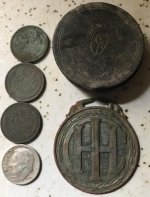Hey y’all, I found this sherd in an area I might plan on searching depending on how old anyone thinks this is. I have tried searching pottery identification resources, and the only one with similar glaze was probably not it. I think it might be old just looking at the clay, or it could be some modern decorative pot. As always thanks for the help!













